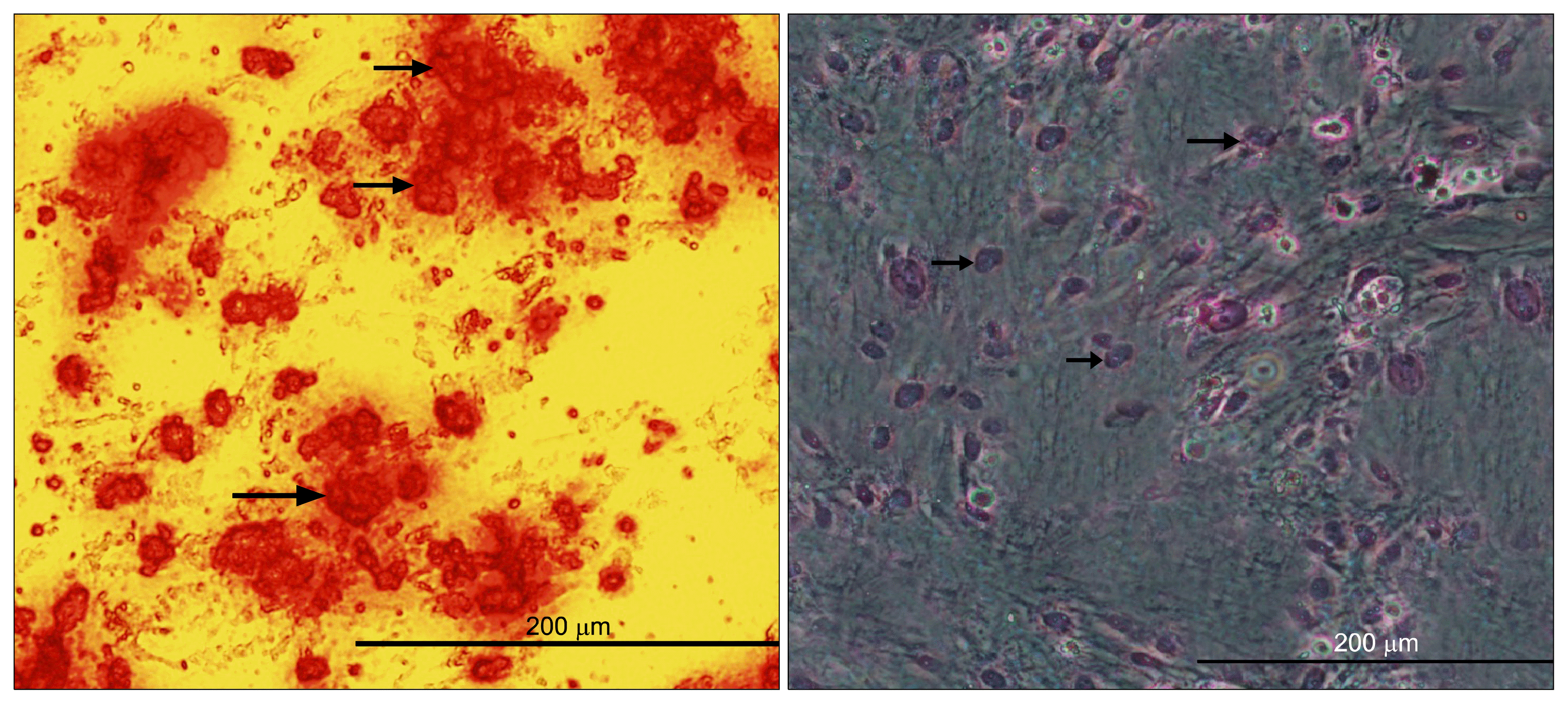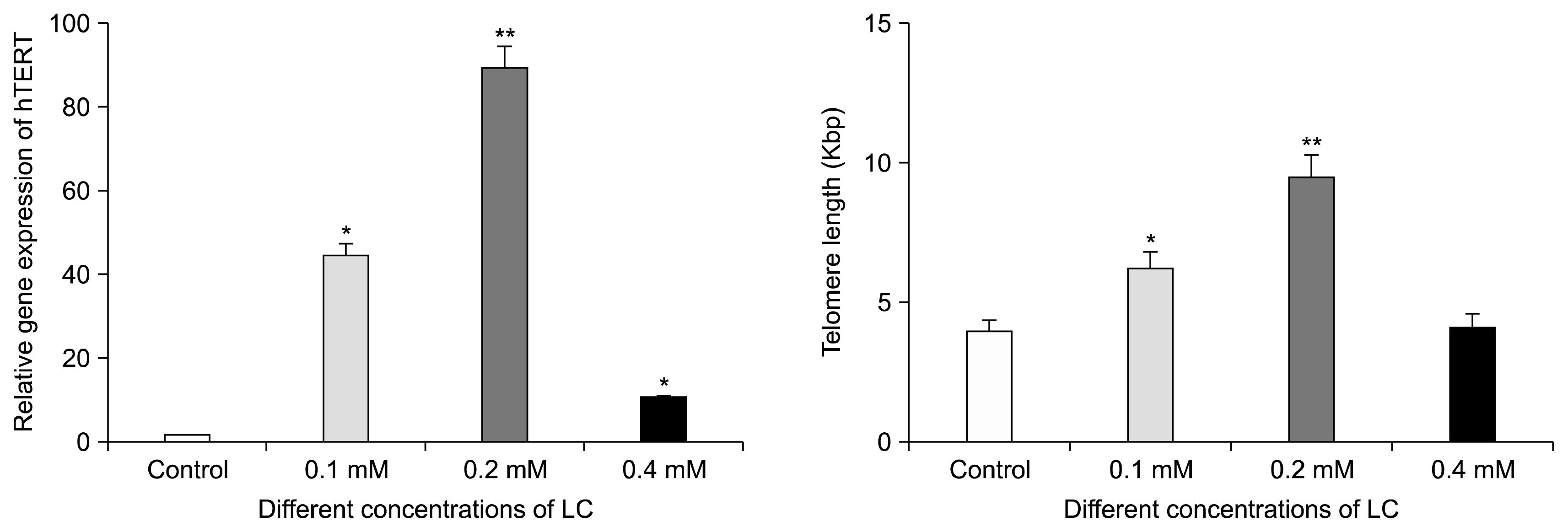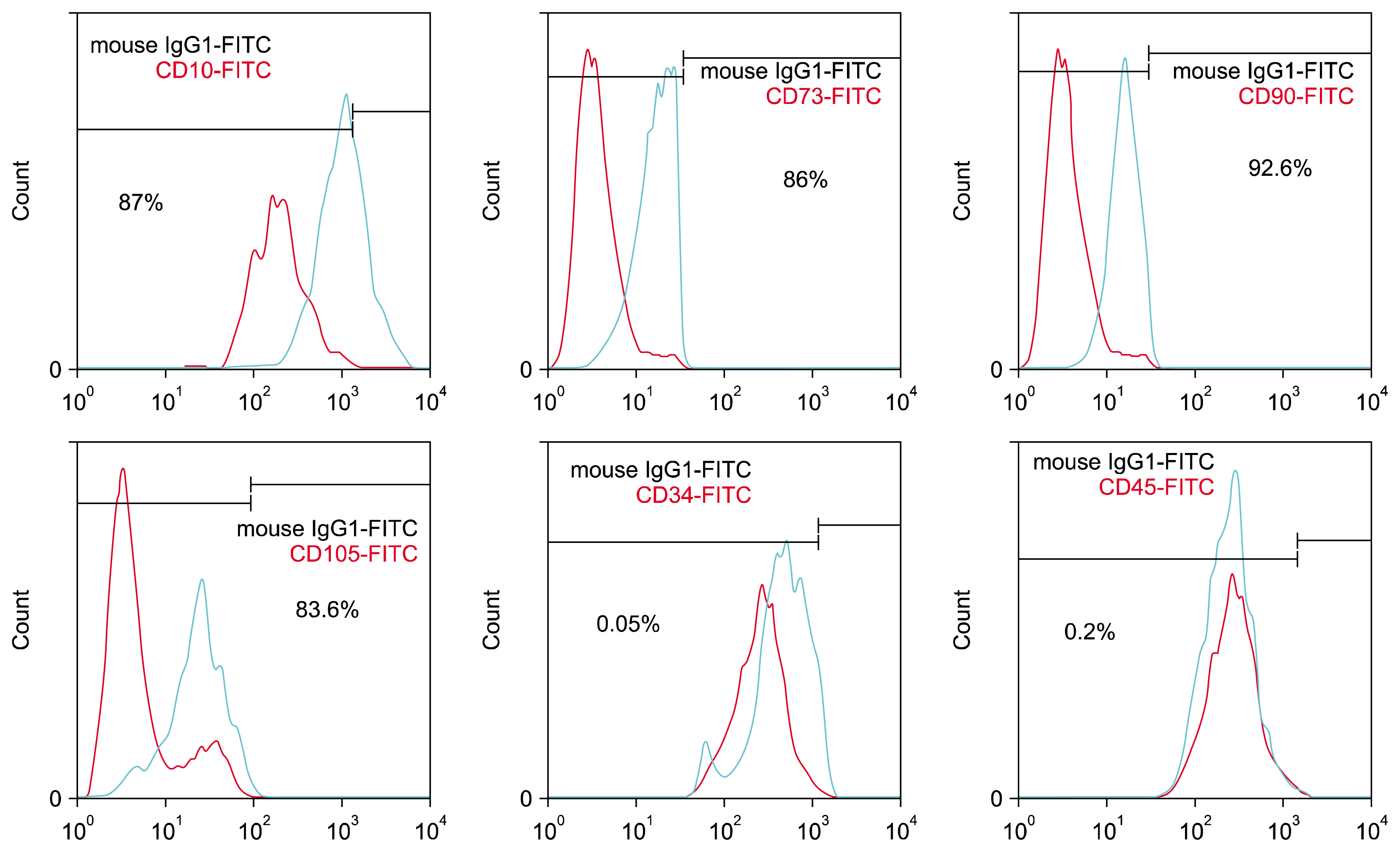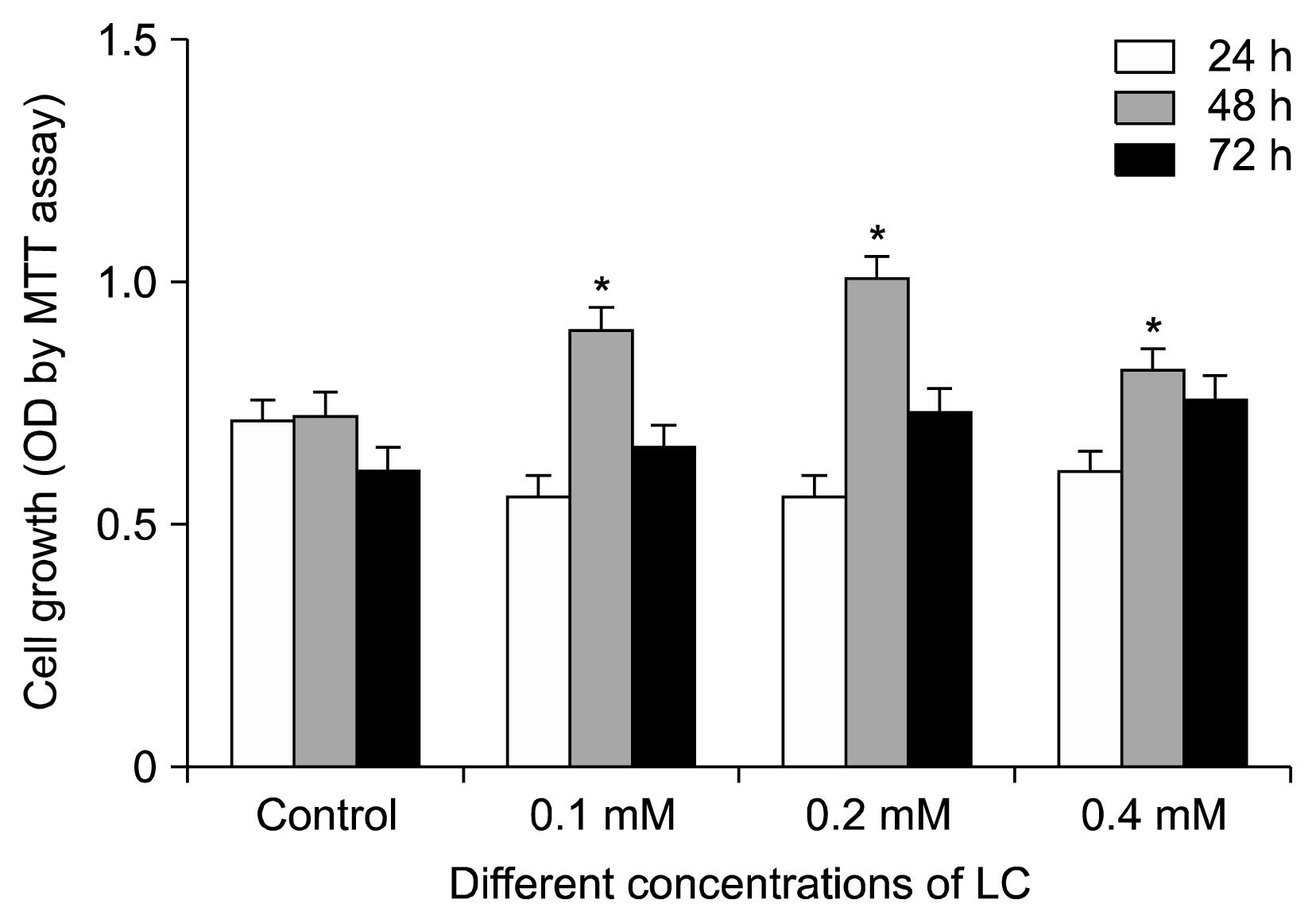1. Misiti S, Nanni S, Fontemaggi G, Cong YS, Wen J, Hirte HW, Piaggio G, Sacchi A, Pontecorvi A, Bacchetti S, Farsetti A. Induction of hTERT expression and telomerase activity by estrogens in human ovary epithelium cells. Mol Cell Biol. 2000; 20:3764–3771. DOI:
10.1128/MCB.20.11.3764-3771.2000. PMID:
10805720. PMCID:
85692.

2. Zimmermann S, Voss M, Kaiser S, Kapp U, Waller CF, Martens UM. Lack of telomerase activity in human mesenchymal stem cells. Leukemia. 2003; 17:1146–1149. DOI:
10.1038/sj.leu.2402962. PMID:
12764382.

4. Li K, Zhu H, Han X, Xing Y. Ectopic hTERT gene expression in human bone marrow mesenchymal stem cell. Life Sci J. 2007; 4:21–24.
5. Böcker W, Yin Z, Drosse I, Haasters F, Rossmann O, Wierer M, Popov C, Locher M, Mutschler W, Docheva D, Schieker M. Introducing a single-cell-derived human mesenchymal stem cell line expressing hTERT after lentiviral gene transfer. J Cell Mol Med. 2008; 12:1347–1359. DOI:
10.1111/j.1582-4934.2008.00299.x. PMID:
18318690. PMCID:
3865677.

6. Beane OS, Fonseca VC, Cooper LL, Koren G, Darling EM. Impact of aging on the regenerative properties of bone marrow-, muscle-, and adipose-derived mesenchymal stem/stromal cells. PLoS One. 2014; 9:e115963. DOI:
10.1371/journal.pone.0115963. PMID:
25541697. PMCID:
4277426.

7. Lu Q, Zhang Y, Elisseeff JH. Carnitine and acetylcarnitine modulate mesenchymal differentiation of adult stem cells. J Tissue Eng Regen Med. 2013; DOI:
10.1002/term.1747. [Epub ahead of print].

8. Syslová K, Böhmová A, Mikoška M, Kuzma M, Pelclová D, Kačer P. Multimarker screening of oxidative stress in aging. Oxid Med Cell Longev. 2014; 2014:562860. DOI:
10.1155/2014/562860. PMID:
25147595. PMCID:
4124763.

9. Calò LA, Pagnin E, Davis PA, Semplicini A, Nicolai R, Calvani M, Pessina AC. Antioxidant effect of L-carnitine and its short chain esters: relevance for the protection from oxidative stress related cardiovascular damage. Int J Cardiol. 2006; 107:54–60. DOI:
10.1016/j.ijcard.2005.02.053.
10. Kitamura Y, Satoh K, Satoh T, Takita M, Matsuura A. Effect of L-carnitine on erythroid colony formation in mouse bone marrow cells. Nephrol Dial Transplant. 2005; 20:981–984. DOI:
10.1093/ndt/gfh758. PMID:
15769817.

11. Kobayashi S, Iwamoto M, Kon K, Waki H, Ando S, Tanaka Y. Acetyl-L-carnitine improves aged brain function. Geriatr Gerontol Int. 2010; 10( Suppl 1):S99–S106. DOI:
10.1111/j.1447-0594.2010.00595.x. PMID:
20590847.

12. Deyhim MR, Mesbah-Namin SA, Yari F, Taghikhani M, Amirizadeh N. L-carnitine effectively improves the metabolism and quality of platelet concentrates during storage. Ann Hematol. 2015; 94:671–680. DOI:
10.1007/s00277-014-2243-5.

13. Hollister L, Gruber N. Drug treatment of Alzheimer’s disease. Effects on caregiver burden and patient quality of life. Drugs Aging. 1996; 8:47–55. DOI:
10.2165/00002512-199608010-00008. PMID:
8785468.
14. Bonavita E. Study of the efficacy and tolerability of L-acetylcarnitine therapy in the senile brain. Int J Clin Pharmacol Ther Toxicol. 1986; 24:511–516. PMID:
3781687.
15. Musicco C, Capelli V, Pesce V, Timperio AM, Calvani M, Mosconi L, Cantatore P, Gadaleta MN. Rat liver mitochondrial proteome: changes associated with aging and acetyl-L-carnitine treatment. J Proteomics. 2011; 74:2536–2547. DOI:
10.1016/j.jprot.2011.05.041. PMID:
21672642.

16. Sener G, Paskaloğlu K, Satiroglu H, Alican I, Kaçmaz A, Sakarcan A. L-carnitine ameliorates oxidative damage due to chronic renal failure in rats. J Cardiovasc Pharmacol. 2004; 43:698–705. DOI:
10.1097/00005344-200405000-00013. PMID:
15071358.

17. Gülçin I. Antioxidant and antiradical activities of L-carnitine. Life Sci. 2006; 78:803–811. DOI:
10.1016/j.lfs.2005.05.103.

18. Thangasamy T, Jeyakumar P, Sittadjody S, Joyee AG, Chinnakannu P. L-carnitine mediates protection against DNA damage in lymphocytes of aged rats. Biogerontology. 2009; 10:163–172. DOI:
10.1007/s10522-008-9159-1.

19. Xiao C, Zhou H, Liu G, Zhang P, Fu Y, Gu P, Hou H, Tang T, Fan X. Bone marrow stromal cells with a combined expression of BMP-2 and VEGF-165 enhanced bone regeneration. Biomed Mater. 2011; 6:015013. DOI:
10.1088/1748-6041/6/1/015013. PMID:
21252414.

20. Li L, Guo Y, Zhai H, Yin Y, Zhang J, Chen H, Wang L, Li N, Liu R, Xia Y. Aging increases the susceptivity of MSCs to reactive oxygen species and impairs their therapeutic potency for myocardial infarction. PLoS One. 2014; 9:e111850. DOI:
10.1371/journal.pone.0111850. PMID:
25393016. PMCID:
4230939.

21. Parsch D, Fellenberg J, Brümmendorf TH, Eschlbeck AM, Richter W. Telomere length and telomerase activity during expansion and differentiation of human mesenchymal stem cells and chondrocytes. J Mol Med (Berl). 2004; 82:49–55. DOI:
10.1007/s00109-003-0506-z.

23. Sharpless NE, DePinho RA. Telomeres, stem cells, senescence, and cancer. J Clin Invest. 2004; 113:160–168. DOI:
10.1172/JCI20761. PMID:
14722605. PMCID:
311439.

24. Baxter MA, Wynn RF, Jowitt SN, Wraith JE, Fairbairn LJ, Bellantuono I. Study of telomere length reveals rapid aging of human marrow stromal cells following in vitro expansion. Stem Cells. 2004; 22:675–682. DOI:
10.1634/stemcells.22-5-675. PMID:
15342932.

26. Britt-Compton B, Wyllie F, Rowson J, Capper R, Jones RE, Baird DM. Telomere dynamics during replicative senescence are not directly modulated by conditions of oxidative stress in IMR90 fibroblast cells. Biogerontology. 2009; 10:683–693. DOI:
10.1007/s10522-009-9216-4. PMID:
19214769.

27. Voghel G, Thorin-Trescases N, Mamarbachi AM, Villeneuve L, Mallette FA, Ferbeyre G, Farhat N, Perrault LP, Carrier M, Thorin E. Endogenous oxidative stress prevents telomerase-dependent immortalization of human endothelial cells. Mech Ageing Dev. 2010; 131:354–363. DOI:
10.1016/j.mad.2010.04.004. PMID:
20399802. PMCID:
3700881.

28. Abou-Zeid L, Baraka HN. Combating oxidative stress as a hallmark of cancer and aging: Computational modeling and synthesis of phenylene diamine analogs as potential antioxidant. Saudi Pharm J. 2014; 22:264–272. DOI:
10.1016/j.jsps.2013.07.009. PMID:
25061412. PMCID:
4099563.

29. Huang H, Liu N, Guo H, Liao S, Li X, Yang C, Liu S, Song W, Liu C, Guan L, Li B, Xu L, Zhang C, Wang X, Dou QP, Liu J. L-carnitine is an endogenous HDAC inhibitor selectively inhibiting cancer cell growth in vivo and in vitro. PLoS One. 2012; 7:e49062. DOI:
10.1371/journal.pone.0049062. PMID:
23139833. PMCID:
3489732.

30. O’Callaghan NJ, Fenech M. A quantitative PCR method for measuring absolute telomere length. Biol Proced Online. 2011; 13:3. DOI:
10.1186/1480-9222-13-3. PMCID:
3047434.







 PDF
PDF Citation
Citation Print
Print




 XML Download
XML Download